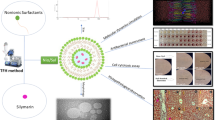Abstract
Purpose. The aim of this work is to evaluate the capability of a series of biocompatible amphiphilic copolymers as a nano-sized drug carrier.
Methods. The influences of the type of lactone monomer, the feed molar ratios of lactone/PEG, and the molecular weight of PEG on the performance and release behavior of micelles are investigated.
Results. These pegylated amphiphilic copolymers efficiently form micelles with a low CMC value in the range of 10−6-10−7 M. The average particle size of micelles is ∼100 nm. The phenomenon of increasing particle size as increasing the chain length of poly(lactone) block is observed. The different hydrophobicity, based on chemical structure of poly(lactone), accounts for different interaction strength between indomethacin and hydrophobic inner core, which further influences the drug loading in copolymeric micelles and their release character. In addition, the PCL/PEG/PCL micellar solutions maintain their sizes at 4°C for 8 weeks without occurring significant aggregation or dissociation.
Conclusions. A series of biocompatible pegylated amphiphilic copolymers have been elucidated possessing micellization potential to form nano-sized micelles in an aqueous environment, which enable incorporate hydrophobic drug and regulate drug release.
Similar content being viewed by others
REFERENCES
H. Liu, S. Farrell, and K. Uhrich. Drug release characteristics of unimolecular polymeric micelles. J. Control. Release 68:167-174 (2000).
V. P. Torchilin. Polymer-coated long-circulating microparticulate pharmaceuticals. J. Microencap. 15:1-19 (1998).
K. Kataoka, G. S. Kwon, M. Yokayama, T. Okano, and Y. Sakurai. Block copolymer micelles as vehicles for drug delivery. J. Control. Release 24:119-132 (1993).
C. Allen, D. Maysinger, and A. Eisenberg. Nano-engineering block copolymer aggregates for drug delivery. Coll. Surf. B: Biointerf. 16:1-35 (1999).
C. Allen, J. Han, Y. Yu, D. Maysinger, and A. Eisenberg. Polycaprolactone-b-poly(ethylene oxide) copolymer micelles as a delivery vehicle for dihydrotestosteron. J. Control. Release 63:275-286 (2000).
C. Allen, Y. Yu, A. Eisenberg, and D. Maysinger. Cellular internalization of PCL(20)-b-PEO(44) block copolymer micelles. Biochim. Biophys. Acta 1421:32-38 (1999).
S. F. Hamm-Alvarez, M. Sonee, K. Loran-Goss, and W. C. Shen. Paclitaxel and nocodazole differentially alter endocytosis in cultured cells. Pharm. Res. 13:1647-1656 (1996).
K. Kataoka, A. Harada, and Y. Nagasaki. Block copolymer micelles for drug delivery: design, characterization and biological significance. Adv. Drug Deliv. Rev. 47:113-131 (2001).
D. Maysinger, O. Berezovska, R. Savic, P. L. Soo, and A. Eisenberg. Block copolymers modify the internalization of micelle-incorporated probes into neural cells. Biochim Biophy. Acta 1539:205-217 (2001).
Y. Mizumura, Y. Matsumura, T. Hamaguchi, N. Nishiyama, K. Kataoka, T. Kawaguchi, W. J. Hrushesky, F. Moriyasu, and T. Kakizoe. Cisplatin-incorporated polymeric micelles eliminate nephrotoxicity, while maintaining antitumor activity. Jpn. J. Cancer Res. 92:328-336 (2001).
H. S. Yoo and T. G. Park. Biodegradable polymeric micelles composed of doxorubicin conjugated PLGA-PEG block copolymer. J. Control. Release 70:63-70 (2001).
S. Y. Leung, J. Jackson, H. Miyake, H. Burt, and M. E. Gleave. Polymeric micellar paclitaxel phosphorylates Bcl-2 and induces apoptotic regression of androgen-independent LNCaP prostate tumors. Prostate 44:156-163 (2000).
J. Taillefer, N. Brasseur, J. E. van Lier, V. Lenaerts, D. Le Garrec, and J. C. Leroux. In-vitro and in-vivo evaluation of pH-responsive polymeric micelles in a photodynamic cancer therapy model. J. Pharm. Pharmacol. 53:155-166 (2001).
J. E. Chung, M. Yokoyama, and T. Okano. Inner core segment design for drug delivery control of thermo-responsive polymeric micelles. J. Control. Release 65:93-103 (2000).
L. W. Juang. Synthesis and characterization of amphiphilic triblock copolymers and their design for drug carriers, MS. thesis, National Taiwan University, College of Pharmacy, Taipei, Taiwan, 2002.
P. Cerrai, M. Tricoli, and F. Andruzzi. Polyether-polyester block copolymers by non-catalysed polymerization of ε-caprolactone with poly(ethylene glycol). Polymer 30:338-343 (1989).
Z. G. Wang, B. S. Hsiao, X. H. Zong, F. Yeh, J. J. Zhou, E. Dormier, and D. D. Jamiolkowski. Morphological development in absorbable poly(glycolide), poly(glycolide-co-lactide) and poly(glycolide-co-cprolactone) copolymers during isothermal crystallization. Polymer 41:621-628 (2000).
A. Saez, M. Guzman, J. Molpeceres, and M. R. Aberturas. Freeze-drying of polycaprolactone and poly(D, L-lactic-glycolic) nanoparticles induce minor particle size changes affecting the oral pharmacokinetics of loaded drugs. Eur. J. Pharm. Biopharm. 50:379-387 (2000).
S. Maiti and P. R. Chatterji. Comparison of the aggregation behavior of di-and triblock nonionic amphiphilies with linear and cyclic hydrophobic tails. Langmuir 13:5011-5015 (1997).
J. S. Hrkach, M. T. Peracchia, A. D. N. Lotan, and R. Langer. Nanotechnology for biomaterials engineering: structural characterization of amphiphilic polymeric nanoparticles by 1H-NMR spevtroscopy. Biomaterials 18:27-30 (1997).
T. Riley, T. Govender, S. Stolnik, S. D. Xiong, M. C. Garnett, L. Illum, and S. S. Davis. Colloidal stability and drug incorporation aspects of micellar-like PLA-PEG nanoparticles. Coll. Sur. B: Biointerfaces 16:147-159 (1999).
H. J. Jeon, Y. I. Jeong, M. K. Jang, Y. H. Park, and J. W. Nah. Effect of solvent on the preparation of surfactant-free poly(DL-lactide-co-glycol) nanoparticles and norfloxacin release characteristics. Int. J. Pharm. 207:99-108 (2000).
Author information
Authors and Affiliations
Corresponding author
Rights and permissions
About this article
Cite this article
Lin, WJ., Juang, LW. & Lin, CC. Stability and Release Performance of a Series of Pegylated Copolymeric Micelles. Pharm Res 20, 668–673 (2003). https://doi.org/10.1023/A:1023215320026
Issue Date:
DOI: https://doi.org/10.1023/A:1023215320026




